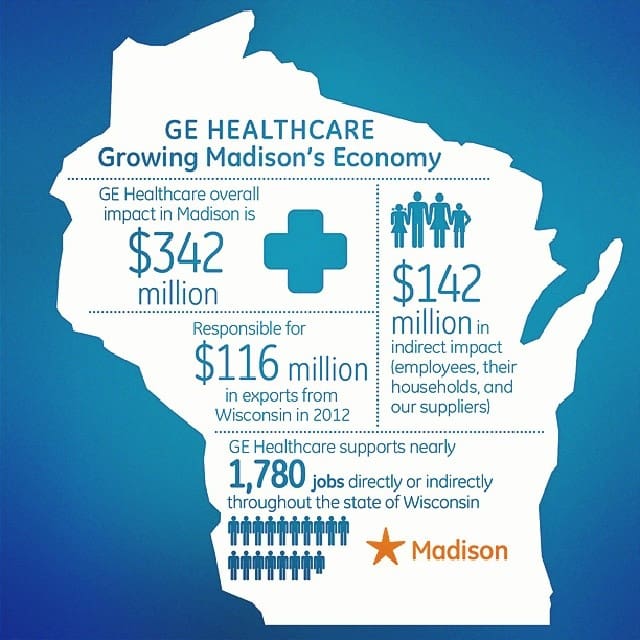Excerpted from Janesville Gazette
By Jim Leute
Tom Eckert heard the same message from employers as president of a technical college in Washington state that he hears now as president of Blackhawk Technical College.
“It doesn’t matter how nice your parks are. Are you going to have the workers that can run my business?”
Leaving one industrialized area, Eckert arrived in Rock County in 2010 to find another that had been crippled in large part because of a devastating national recession.
Many companies that survived have done so because of newfound efficiencies and a conversion to what’s known as advanced manufacturing, generally defined as the use of technology to improve products and processes.
Eckert immediately recognized the need for Blackhawk to help connect local students and employers in the new manufacturing model.
The result is Blackhawk’s Advanced Manufacturing Center, the goal of which is to create a talent pipeline to local employers. The first phase will open this fall in a renovated Milton building that was the former home to ANGI Energy Systems.
The idea is to consolidate all of BTC’s manufacturing programs into a space that’s more than double what’s devoted to the programs at BTC’s central campus. The center will include new equipment, labs and classrooms that lend themselves to cross training among several disciplines.
It also will include an advanced program lab where students in different programs work together.
“The programs will get together and build something. The instructors will break it, and then the students will fix it and tear it down again,” Eckert said. “People in different disciplines have to work with others, and they’ll be able to do so at the new center.”
Eckert said the face of manufacturing is changing radically, and the need for highly trained technicians has never been greater. Blackhawk’s capacity is tapped out, and the new facility will not only provide more space, it also will deliver better-trained students to help fill the local workforce gap.
Eckert and others have said employers have expressed a critical need for more skilled workers in areas such as CNC, electro-mechanical, industrial maintenance mechanics and welding.
“The new center will look like modern manufacturing,” he said.
Garry Krause came to Blackhawk last year as the dean of advanced manufacturing and transportation. The new center in Milton quickly topped his list of priorities.
“It’s very exciting to be a part of this,” he said. “It’s all so very innovative.
“Too often, we end up with silos. Welders don’t necessarily understand the issues machinists face, and machinists don’t understand the things welders deal with. With this center, we can bring them together and create a much more flexible employee.”
Renovation of the Plumb Street facility is ongoing. Blackhawk expects to move its welding, CNC and industrial mechanic programs to the facility this fall. Automation, HVAC and mechanical design will follow in fall 2015.
When complete, the $12 million center will have more than 100,000 square feet in which the programs can work together to produce employees that Eckert said are in demand—both now and in the future. An anonymous donor has committed $600,000, and the remainder will come from operating budgets and bonding.
“We are working very closely with industry, and we will be on the cutting edge,” he said. “So many people think of manufacturing in the way it was in the 1970s.
“But so much has changed, and we think many of our students will pursue dual degrees because of the new center. Those are people employers need, and the pay is very good.”
Eckert said he has yet to hear a negative comment about the center.
“Our business partners are thrilled; Milton is very enthusiastic about getting the center up there, and our economic development people are bragging up the center wherever they go,” he said.
One of those business partners is United Alloy, the Janesville company that provides custom metal fabrication and powder coating services. Its products include diesel fuel tanks and generator frames.
The company, which is currently doubling the size of its plant, has historically been in search of welders.
Shannon Moe, the company’s human resources manager, said the new BTC facility will turn out better students.
She said the center’s state-of-the-art technology and equipment will allow students to learn more, in some cases even learning customized welds that local companies use.
“The ability for these students to learn multiple things is wonderful,” she said. “Any time you can pick up more skill sets, you’re a more rounded employee, and you can learn and grow with the company.”
James Otterstein, Rock County’s economic development director, is equally excited for the innovations the new center will provide.
There are several examples of consortiums, partnerships and other shared-facility training centers around the country, he said, but few share the Blackhawk model’s characteristics.
“Very few are equipped with the appropriate facility layout, integrated technology or the modern equipment necessary to create a value-added, integrated training environment,” he said.
Even fewer, he added, have the ability that Blackhawk will have to open its facility to area companies in need of prototyping, research and development or other testing.
“Efficiencies, productivity, quality, safety and cost-control standards—driven by continuous innovation and technology—are the premiums separating those firms that are struggling and those that are growing,” Otterstein said.
The center will be a showcase that ties directly into the recently launched Inspire Rock County program that connects middle and high school students with manufacturing careers, he said.
“It’s critical for younger people to think about higher education earlier,” Eckert said. “These young people, as well as those underemployed, need to look at the two- and four-year programs that are out there and decide where their passion leads them.
“The Advanced Manufacturing Center will be a wonderful option that we think will lead to a long-term solution.”
Read the full article.


 To highlight GE Healthcare’s impact in the region last week, MadREP partnered with GE Healthcare and BioForward during a panel discussion focused on med-tech innovation, manufacturing, and high tech jobs, with much of the conversation centering on the region’s capacity across these industries.
To highlight GE Healthcare’s impact in the region last week, MadREP partnered with GE Healthcare and BioForward during a panel discussion focused on med-tech innovation, manufacturing, and high tech jobs, with much of the conversation centering on the region’s capacity across these industries.